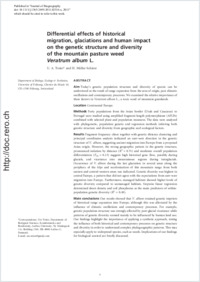Differential effects of historical migration, glaciations and human impact on the genetic structure and diversity of the mountain pasture weed Veratrum album L.
- Treier, Urs A. Department of Biology, Ecology & Evolution, University of Fribourg, Switzerland - Aarhus University, Danemark
- Müller-Schärer, Heinz Department of Biology, Ecology & Evolution, University of Fribourg, Switzerland
-
18.05.2011
Published in:
- Journal of Biogeography. - 2011, vol. 38, p. 1- 16
English
Aim Today’s genetic population structure and diversity of species can be understood as the result of range expansion from the area of origin, past climatic oscillations and contemporary processes. We examined the relative importance of these factors in Veratrum album L., a toxic weed of mountain grasslands. Location Continental Europe.Methods Forty populations from the Asian border (Urals and Caucasus) to Portugal were studied using amplified fragment length polymorphisms (AFLPs) combined with selected plant and population measures. The data were analysed with phylogenetic, population genetic and regression methods inferring both genetic structure and diversity from geographic and ecological factors.Results Fragment frequency clines together with genetic distance clustering and principal coordinates analysis indicated an east–west direction in the genetic structure of V. album, suggesting ancient migration into Europe from a proposed Asian origin. However, the strong geographic pattern in the genetic structure, pronounced isolation by distance (R² = 0.74) and moderate overall population differentiation (FST = 0.13) suggests high historical gene flow, possibly during glacials, and vicariance into mountainous regions during interglacials. Occurrence of V. album during the last glaciation in several areas along the periphery of the Alps and recolonization of this mountain range from both eastern and central–western areas was indicated. Genetic diversity was highest in central Europe, a pattern that did not agree with the expectations from east–west migration into Europe. Furthermore, managed habitats showed higher levels of genetic diversity compared to unmanaged habitats. Stepwise linear regression determined shoot density and soil phosphorus as the main predictors of within-population genetic diversity (R² = 0.40).Main conclusions Our results showed that V. album retained genetic imprints of historical range expansion into Europe, although this was alleviated by the influence of climatic oscillations and contemporary processes. For example, genetic population structure was strongly affected by post-glacial vicariance while patterns of genetic diversity seemed mainly to be influenced by human land use. Our findings highlight the importance of applying a synthetic approach, testing the influence of both historical and contemporary processes on genetic structure and diversity in order to understand complex phylogeographic patterns. This may especially apply to widespread species, such as weeds. Implications of our findings for biological control are briefly discussed.
- Faculty
- Faculté des sciences et de médecine
- Department
- Département de Biologie
- Language
-
- English
- Classification
- Ecology and biodeversity
- License
- License undefined
- Identifiers
-
- RERO DOC 23190
- DOI 10.1111/j.1365-2699.2011.02516.x
- Persistent URL
- https://folia.unifr.ch/unifr/documents/301877
Other files
Statistics
Document views: 91
File downloads:
- tre_deh.pdf: 193
- tre_deh_sm.pdf: 130

